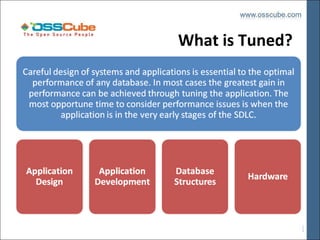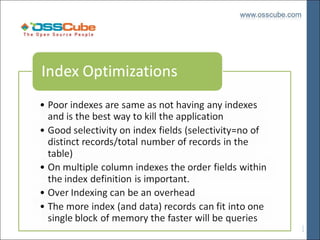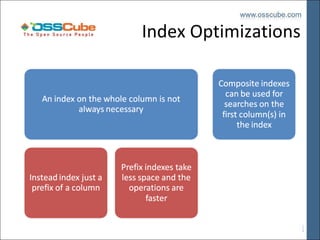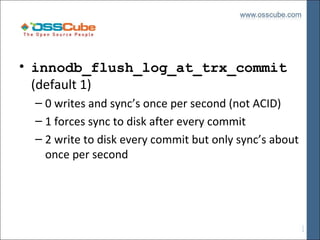MySQL Performance Tuning - GNUnify 2010
- 1. Secrets of Best MySQL Optimization presented by Sonali Minocha OSSCube
- 2. Who Am I?
- 3. Why Tune a Database?
- 4. Who Tunes?
- 6. How much tuning is enough?
- 15. EXPLAIN Types system The table has only one row const At the most one matching row, treated as a constant eq_ref One row per row from previous tables ref Several rows with matching index value ref_or_null Like ref, plus NULL values index_merge Several index searches are merged unique_subquery Same as ref for some subqueries index_subquery As above for non-unique indexes range A range index scan index The whole index is scanned ALL A full table scan
- 16. EXPLAIN Extra Using index The result is created straight from the index Using where Not all rows are used in the result Distinct Only a single row is read per row combination Not exists A LEFT JOIN missing rows optimization is used Using filesort An extra row sorting step is done Using temporary A temporary table is used Range checked for each record The read type is optimized individually for each combination of rows from the previous tables
- 17. Optimizer Hints STRAIGHT_JOIN Forces the optimizer to join the tables in the given order SQL_BIG_RESULTS Together with GROUP BY or DISTINCT tells the server to use disk-based temp tables SQL_BUFFER_RESULTS Tells the server to use a temp table, thus releasing locks early (for table-locks) USE INDEX Hints to the optimizer to use the given index FORCE INDEX Forces the optimizer to use the index (if possible) IGNORE INDEX Forces the optimizer not the use the index
- 18. Selecting Queries to Optimize • The slow query log – Logs all queries that take longer than long_query_time – Can also log all queries that don’t use indexes with --log-queries-not-using-indexes – To log slow administrative commands use --log-slow-admin-statements – To analyze the contents of the slow log use mysqldumpslow
- 19. • The general query log can be use to analyze: – Reads vs. writes – Simple queries vs. complex queries – etc
- 21. Normalization
- 23. Choosing Best Suited Storage Engine • Understanding benefits and drawbacks of each storage engine is very important while designing application. • Different storage engine has different index capability ,application need should be kept in mind while choosing storage engine
- 25. InnoDB-Specific Optimizations • InnoDB uses clustered indexes – The length of the PRIMARY KEY is extremely important • The rows are always dynamic – Using VARCHAR instead of CHAR is almost always better • Maintenance operations needed after – Many UPDATE/DELETE operations • The pages can become underfilled
- 26. Monitoring Threads in MySQL
- 30. Tuning MySQL Parameters • Some MySQL options can be changed online • The dynamic options are either – SESSION specific • Changing the value will only affect the current connection – GLOBAL • Changing the value will affect the whole server – Both • When changing the value SESSION/GLOBAL should be specified
- 31. • Online changes are not persistant over a server restart – The configuration files have to be changed as well • The current values of all options can be found with SHOW SESSION/GLOBAL VARIABLES
- 32. Status Variables
- 33. SQL/Parser Model Client1 Client2 ClientN MySQL Server Connection Thread Pool Query Cache Parser Query Optimizer Storage Engines 101101 InnoDB MyISAM MERGE MEMORY Federated ARCHIVE NDBCluster
- 34. Query Cache • Stores SELECT queries and their results • Purpose: improve performance for frequently requested data • The data in the query cache is invalidated as soon as a modification is done in the table • Controlled with the query_cache_size variable
- 35. • The Qcache_% status variables help monitoring the cache – The utilisation ratio: Qcache_hits vs. Com_select • The query cache can be emptied with RESET QUERY CACHE
- 36. Some Thread Specific Options • read_buffer_size (default 128Kb) and read_rnd_buffer_size (default 256Kb) – Size of cache used for table scanning – Not equivalent to block size • The database is not divided into blocks but directly into records – Increase if you do many sequential scans • sort_buffer_size (default 2Mb) – Size of the GROUP BY / ORDER BY cache – If more memory is needed it will be taken from the disk • tmp_table_size (default 32Mb) – Limit after which temporary tables will not be MEMORYs anymore, but MyISAM tables
- 37. Some Global Options • table_cache (default 64) – Cache for storing open table handlers – Increase this if Opened_tables is high • thread_cache (default 0) – Number of threads to keep for reuse – Increase if threads_created is high – Not useful if the client uses connection pooling
- 38. • max_connections (default 100) – The maximum allowed number of simultaneous connections – Very important for tuning thread specific memory areas – Each connection uses at least thread_stack of memory
- 39. MyISAM Global Options • key_buffer_size (default 8Mb) – Cache for storing indices – Increase this to get better index handling – Miss ratio (key_reads/key_read_requests) should be very low, at least < 0.03 (often < 0.01 is desirable) • Row caching is handled by the OS
- 40. MyISAM Thread-Specific Options • myisam_sort_buffer_size (default 8Mb) – Used when sorting indexes during REPAIR/ALTER TABLE • myisam_repair_threads (default 1) – Used for bulk import and repairing – Allows for repairing indexes in multiple threads • myisam_max_sort_file_size – The max size of the file used while re-creating indexes
- 41. InnoDB-Specific Optimization • innodb_buffer_pool_size (default 8Mb) – The memory buffer InnoDB uses to cache both data and indexes – The bigger you set this the less disk i/o is needed – Can be set very high (up to 80% on a dedicated system)
- 42. • innodb_flush_log_at_trx_commit (default 1) – 0 writes and sync’s once per second (not ACID) – 1 forces sync to disk after every commit – 2 write to disk every commit but only sync’s about once per second
- 43. InnoDB-Specific Optimization • innodb_log_buffer_size (default 1Mb) – Larger values allows for larger transactions to be logged in memory – Sensible values range from 1M to 8M • innodb_log_file_size (default 5Mb) – Size of each InnoDB redo log file – Can be set up to buffer_pool_size
- 44. QnA
- 45. Thank you for your time and attention www.osscube.com For more information, please feel free to drop in a line to sonali@osscube.com or visit http://www.osscube.com













































